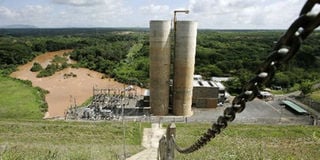Kenya: Masinga dam closed over drought

The Masinga dam water catchments. Photo/FILE
The cost of electricity is expected to shoot up as Kenya turns to fuel-fired generators as water resources dwindle.
Kenya Electricity Generating Company on Tuesday said it had shut down the 14-megawatt Masinga Dam last week due to low water levels.
On Tuesday, the firm advertised for a 40 megawatt diesel power generator weeks after distributor Kenya Power & Lighting Company sought to requisition three such units.
These thermal generators are reflected in your power bill as fuel and forex adjustment.
The water level has fallen sharply following prolonged drought, forcing State to extend the contract of the expensive emergency generator, Aggreko.
Impact of closure
On Tuesday, KenGen down played the impact of the closure of Masinga Dam as the water would be cascaded to Kamburu Dam to enhance production.
“KenGen has been running Masinga Power Station below the minimum operating level of 1,037 metres above sea level for the last three weeks and the remaining water in the dam could not sustain any further generation at the station,” read a statement attributed to acting managing director Richard Nderitu.
According to Mr Nderitu, running of the station at a lower water level would have exposed the machines to damage and closing it down was the most prudent operation under the current circumstances.
At the time of closure the dam level stood at 1,035.5 metres above sea level; one and half metres below the recommend minimum operating level.
As a result, company engineers have started releasing the remaining water in the dam through the low level outlet to boost the level of Kamburu Power Station, the second station on the Seven Forks cascade.
“While the shut down of Masinga is expected to result in a 14-megawatt reduction in the power produced, the subsequent raising of the level of Kamburu Dam will mean better efficiencies,” the firm said.
Over the past two years, water levels at Masinga have declined steadily due to poor hydrology.
The inadequate rainfall experienced around the country has further aggravated the situation.
Elsewhere KPLC is casting the net wider and on Monday entered into power purchase negotiations with two investors under the Feed in Tariff (FIT) Policy.
The deal with Genpro Power Systems (EA) and Kenya Tea Development Authority’s Imenti Tea Factory will be lodged with Electricity Regulatory Authority for approval.
Genpro has proposed to sell to KPLC three megawatts of power from their hydro power plant by March 2012.
On the other hand, Imenti Tea Factory proposes to sell 284 kilowatts from their existing plant, which has a 900 kilowatts capacity from October this year.




